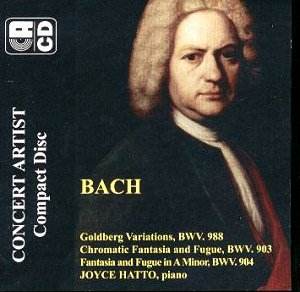This is the first of Joyce Hatto’s two Bach discs currently
available from Concert Artist. Her exceptionally convincing traversals
of the Russian literature have been covered here as has her Chopin,
amongst other things. Clearly she learned much from her teacher Serge
Krish who must equally have exerted a powerful influence on her Bach
playing. Here she plays the Goldberg Variations adding the Chromatic
Fantasia and Fugue and the Fantasia and Fugue in A, BWV 904.
Hatto’s view of the Variations is one of consonance
and surety of architectural vision – a wholeness in other words that
abjures speculative or incidental moments, though this is not to say
that she is indifferent to such things. Her own notes allude to the
issue for example of the repeats in the Goldberg Variations and she
generally omits them except in the cases of the canons or variation
25 (the Landowska "Black Pearl"). Hers is pragmatic and experienced
music-making. When it comes to ornaments she is tasteful and frequently
highly impressive. Generally her legato is employed with romantic understanding
but she manages to retain clarity even at some of the slower tempi she
adopts. There is no over nuancing and there are no damagingly stabbed
staccato accents. The right hand is attractively plaint but not bathed
in a romanticised halo of over pedalling.
She takes both repeats in the Aria, the free flowing
semi quavers quite quick, ornaments tasteful and apposite. She is light
and rhythmically acute in the first variation – but has a most impressive
way of not seeming fast. In the Allegretto second variation her legato
is sustained; she doesn’t much favour détaché phrasing
and avoids hints of heaviness. Non-staccato in the bass she makes no
attempts at imitation of harpsichord sonority in the first canon but
the Handelian sounding fourth variation sounds rather slow and relatively
lifeless. The fifth immediately restores things – no rush but spruce
rhythm and clarity of entries. I admired the legato veil she conjures
in the second canon without any stabbing accents and in the following
variation she employs ornaments once again with clarity – nothing is
clotted or confused. When she does utilise a harder bass line accenting
– as she does, say, in the Allegro eighth variation - it is perfectly
rounded. I was unsure about the ninth and tenth; she is really quite
slow and whilst there is elegance in profusion in the third canon, the
Fughetta tenth sounds to me over emphatic and stolid. There is tonal
bloom and judicious weight in the Andantino thirteenth and some quick
humour in the bass pointing of the Allegro moderato fourteenth variation.
In terms of timing she is as slow as (final recording) Gould in the
fifth canon but she manages to bring a sensitive warmth and direction
to it that is unmistakeably one of her most deeply rooted virtues in
this music.
The Overture sixteenth opens with rather heavy tread
– the dotted rhythms don’t really sound ideally free but the fughetto
is played with careful attention to dynamic variance and the left hand
is strongly shaped and animated. She takes crucial extra time in the
seventeenth by which to articulate the various intoxicating voicings
– impressive indeed – and the succeeding canon is again very modestly
paced. Her gravity in the Allegro twentieth is palpable – and the extra
time (even if no more than 10 seconds more than, say, Craig Sheppard)
makes a real difference to the character of the variation. She is ostensibly
quite slow in the seventh canon but keeps it flowing forward accompanied
by little nuances of dynamic inflection. Strong and forcible in the
Alle breve twenty-second I found that at her adopted tempo in the following
variation the humour is more than a little laboured. By the eighth canon
I was aware that there was sometimes a lack of differentiation of tone
in the performance, that Hatto’s arching imperatives came into conflict
with the individual life of each variation. Still, the moderato twenty-sixth
flows evenly and there is a welcome lack of brittleness and hardening
in the ninth canon – her little agogics are delightful and her potential
for contrastive colouration optimum. Bluff rather than ponderous in
the Allegro twenty-eighth the inner voiced trills are somewhat too recessed
and whilst she is clear and precise in the Brillante twenty-ninth she
is, once more, slow. The gravity she brings to the Quodlibet – spacious,
considered, very slow is in itself remarkable but I found it lacked
joy and surge and that the diminuendo and lengthy pause before the return
of the Aria sapped the final moments of cumulative, vexatious and contrary
meaning - and also of moving depth as well. Others may well feel differently
and indeed differently about the whole performance. I found it a deeply
pondered arch, an attempt at binding the variations through a spine
of consonance but one about which I had some strong misgivings and found
frustratingly uneven.
Her Chromatic Fantasia and Fugue is neither over stressed
nor over pedalled. She doesn’t strive for huge dynamic gradients, instead
developing some considerable intensity as the Fantasia develops and
her Fugue generates a pealing grandeur. The softened dynamics of the
A minor Fugue and the way she brings out the bass melody are tremendously
attractive, animated by a generous romanticism.
Jonathan Woolf
MusicWeb now offers the complete
Concert Artist catalogue
